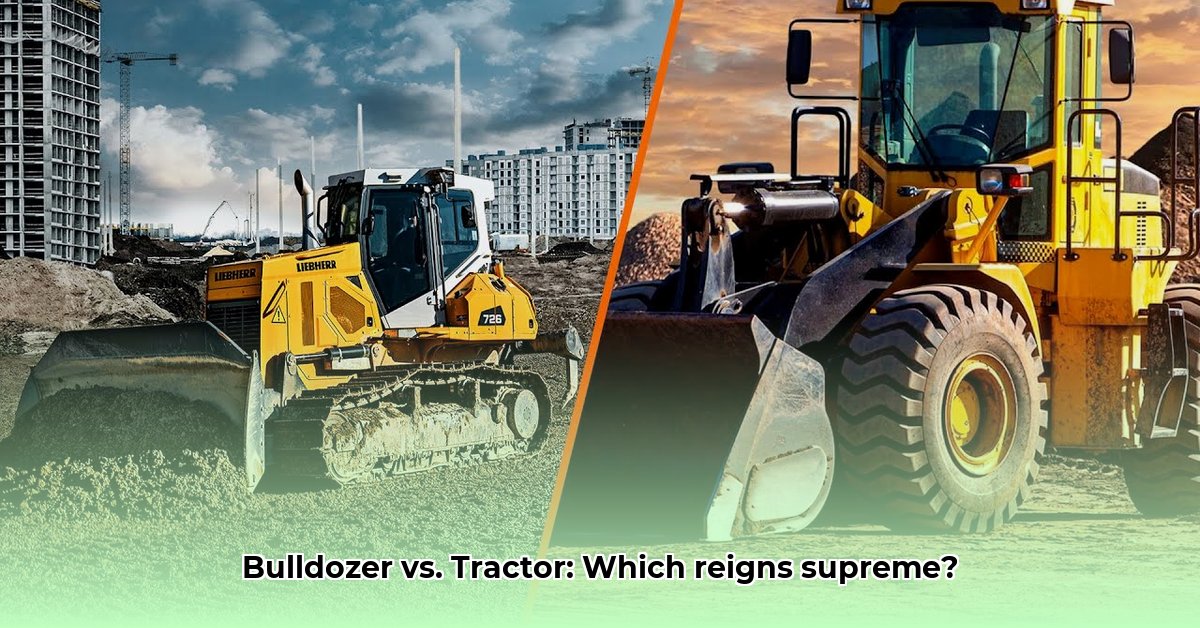
Bulldozer vs. Tractor: Key Differences
Choosing between a bulldozer and a tractor depends heavily on your specific needs. These powerful machines excel in different areas. A bulldozer is a powerhouse built for moving massive amounts of earth, while a tractor is a versatile workhorse suitable for a wider range of tasks with the right attachments. But which is right for your project? For more on smaller tractors, check out compact tractor information.
| Feature | Bulldozer | Tractor |
|---|---|---|
| Primary Use | Large-scale earthmoving, land clearing | Farming, landscaping, light construction |
| Power | High horsepower, substantial engine power | Powerful engine, generally lower horsepower |
| Mobility | Tracks for superior traction on rough terrain | Wheels or tracks; adaptable to terrain type |
| Maneuverability | Limited maneuverability, wide turning radius | Generally more maneuverable |
| Attachments | Primarily blades (straight, U-shaped, angled) | Wide variety: plows, loaders, backhoes, etc. |
| Cost | High initial and ongoing operating costs | Lower initial and ongoing operating costs |
Bulldozers: Masters of Earthmoving
Bulldozers are the heavy hitters of the construction and land-clearing world. Their immense power makes them ideal for moving large volumes of earth, rock, and debris. Think major road construction, land clearing for development, or mining operations. Their sheer power is unmistakable.
Types of Bulldozer Blades
Different blade types cater to specific needs:
- Straight Blade: General-purpose pushing and moving.
- U-shaped Blade: Excellent for moving material uphill or downhill.
- Angled Blade: Precise grading and ditching.
Choosing the right blade directly impacts efficiency and project completion time.
Bulldozer Applications
Bulldozers are indispensable for:
- Large-scale construction projects (roads, buildings).
- Land clearing.
- Mining operations.
- Site preparation.
Bulldozer Operation and Maintenance
Operating a bulldozer requires training and experience due to its size and power. Regular maintenance includes inspections, repairs, and lubrication to assure smooth operation and safety. Ignoring maintenance leads to costly downtime.
Bulldozer Costs
Bulldozers represent a substantial investment. Initial purchase price, fuel costs, and maintenance contribute to high ongoing operational expenses. Larger models naturally command higher costs.
Tractors: Versatile Workhorses
Tractors offer unmatched versatility. Their adaptability, coupled with a wide array of attachments, makes them suitable for a vast range of applications, extending far beyond agricultural tasks.
Types of Tractors
Tractors come in two main variations:
- Wheeled Tractors: Ideal for smoother terrain and higher speeds.
- Tracked Tractors: Superior traction on uneven or soft ground.
The terrain dictates the best choice.
Tractor Attachments
The versatility of tractors stems from their ability to work with numerous attachments, including:
- Plows
- Cultivators
- Loaders
- Backhoes
- Mowers
This adaptability makes them suitable for various tasks.
Tractor Operation and Maintenance
Tractor operation requires proper training, though generally less intensive than bulldozer operation. Regular maintenance is crucial for optimal performance and longevity. Regular servicing and inspections are key.
Tractor Costs
Tractors offer a more affordable alternative to bulldozers, both in terms of initial purchase price and ongoing operational costs. However, costs still vary greatly depending on size, features, and attachments.
Choosing the Right Machine: A Decision-Making Guide
This flowchart helps navigate the decision-making process:
- Project Scale: Large-scale earthmoving? (Yes: Bulldozer; No: Proceed to step 2)
- Terrain: Uneven or challenging terrain? (Yes: Tracked vehicle (bulldozer or tractor); No: Proceed to step 3)
- Budget: Limited budget? (Yes: Tractor; No: Bulldozer)
- Tasks: Multiple tasks requiring diverse attachments? (Yes: Tractor; No: Bulldozer)
Conclusion
Selecting between a bulldozer and a tractor hinges on carefully considering your specific project requirements, budget constraints, and the terrain. This guide provides a framework for making an informed decision. Remember to prioritize safety and proper training in operating heavy equipment.
Appendix: Resources
- Manufacturer Websites – Access specifications and detailed information on various models.
- OSHA Safety Guidelines – Consult safety regulations for operating heavy machinery.